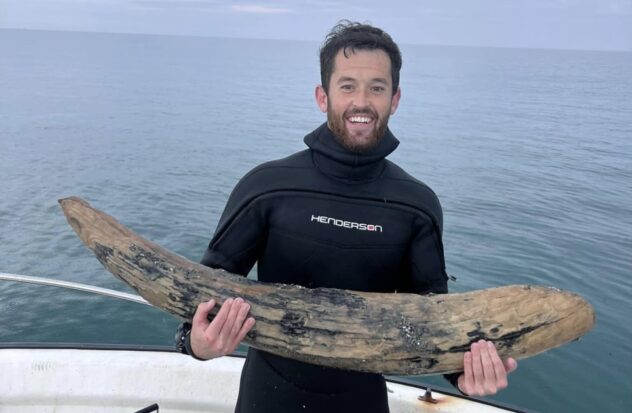A fossil hunter made a unusual find in waters off the west coast of Florida, in the Gulf of Mexico: a gigantic tusk of a mastodon or mammoth.
At the end of April, while diving about seven meters deep, a mile off Venice, Alex Lundberg found a tusk 4.5 feet long (almost one and a half meters) and weighing 60 pounds.
Lundberg said he’s pretty sure the tusk is from a mastodon.based on its shape, although he did not rule out that it could be from a mammoth.
“Based on other fossils we have found there, our best estimate is that the site is from the mid to late Pleistocene,” Lundberg told the news channel. Local 10 News. “That is, about 500,000 years in the oldest and 10,000 in the youngest.”
Lundberg reported his find to the Florida Museum of Natural History, fulfilling a requirement of his fossil hunting permit.
According to information collected on the project site Me Goddess Designsof which Lundberg is a part He is a fossil hunter and collector based in the southwest of the state, with a degree in Marine Biology from the University of South Florida (USF), in addition to studies at James Cook University in Australia and the Bermuda Institute of Ocean Sciences. Today, he spends most of his time exploring the Gulf and nearby lands in search of fossils.
The area of the Gulf of Mexico, in front of Venice, is a paradise for fossil huntersstressed the report of Local 10 News.
Scientists claim that mastodons weighed between 4 and 6 tons and measured between 2.5 and 3 meters.
He American Mastodon is an extinct family of proboscidean mammals, commonly known as mastodons. They differ from mammoths, which belong to the genus Mammuthus of the family Elephantidaepoints out Wikipedia citing scientific literature.
“The family is distantly related to that of the elephantids, where current elephants are classified. “It appeared in Eurasia, in the Oligocene, about 20 million years ago, and from there it spread to both Africa and America, where the family persisted until the Pleistocene and even the Holocene (current era),” explains the popular encyclopedia about those extinct prehistoric animalswhose fossils have been found in North America.
According to the publication, scientists estimate that the extinction of the last species, American mammoth10,000 to 8,000 years ago, was accelerated by hunting practiced by the first human settlers of the Americas.


